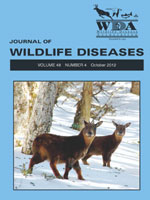Free-ranging Alaskan moose calves (Alces alces gigas) were immobilized with 0.12 mg/kg sufentanil (S; n=16), 0.12 mg/kg sufentanil plus 0.27 mg/kg xylazine (SX; n=11), or 0.007 mg/kg carfentanil plus 0.36 mg/kg xylazine (CX; n=13). Immobilants were antagonized with 1.2 mg/kg naltrexone (S) or 1.2 mg/kg naltrexone plus 2.4 mg/kg tolazoline (SX, CX). There were no differences in induction (P≥0.29) or processing (P≥0.44) times between groups. Moose given either S or SX had significantly shorter recovery times than moose given CX (P=0.001) and recovery times from S were shorter than from SX (P=0.02). Oxygen saturation values for all groups averaged 85±8%, but were significantly higher (P=0.048) for CX (89±7%) than for S (82±8%). Based on these data, sufentanil at 0.1 mg/kg or sufentanil at 0.1 mg/kg plus xylazine at 0.25 mg/kg could provide effective remote immobilization for Alaskan moose calves and could be substituted for carfentanil or thiafentanil should the need arise.
BioOne.org will be down briefly for maintenance on 14 May 2025 between 18:00-22:00 Pacific Time US. We apologize for any inconvenience.
How to translate text using browser tools
1 October 2012
Sufentanil Citrate Immobilization of Alaskan Moose Calves
Terry J. Kreeger,
Kalin A. Kellie
ACCESS THE FULL ARTICLE

Journal of Wildlife Diseases
Vol. 48 • No. 4
October 2012
Vol. 48 • No. 4
October 2012
Alaska
Alces alces gigas
carfentanil
immobilization
moose
sufentanil
xylazine




